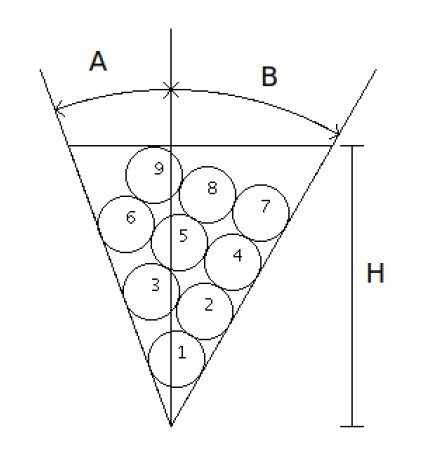当前你的浏览器版本过低,网站已在兼容模式下运行,兼容模式仅提供最小功能支持,网站样式可能显示不正常。
请尽快升级浏览器以体验网站在线编辑、在线运行等功能。
3453:Fruit Bowl
题目描述
For her next project, Beebe Flat wishes to paint a bowl of fruit.Naturally, the bowl is two-dimensional, as is all of the fruit. She bought a triangular bowl which somehow always manages to stay upright, with a perfectly level top. The bowl has a height H, and opens A degrees to the left and B degrees to the right
(see diagram).
chooses bowls such that, when properly packed, the last piece of fruit to fit will be at least 10-2 below the top, and the next piece of fruit that would fit if the bowl were taller will jut out at least 10-2 above the top.Given a particular bowl, how many pieces of fruit does Beebe need to buy to fill the bowl in this manner?
(see diagram).

chooses bowls such that, when properly packed, the last piece of fruit to fit will be at least 10-2 below the top, and the next piece of fruit that would fit if the bowl were taller will jut out at least 10-2 above the top.Given a particular bowl, how many pieces of fruit does Beebe need to buy to fill the bowl in this manner?
输入解释
The input consists of multiple test cases. Each test case has three integers on a single line, denoting A, B,and H. 1 <= A,B <= 45, A 6= B, and 1 <= H <= 300. The last test case will be followed by A = B = H = 0,which should not be processed.
输出解释
For each test case, print on a single line the number of pieces of fruit that Beebe needs to buy to fill the given bowl.
输入样例
20 30 10 10 20 20 0 0 0
输出样例
9 25
来自杭电HDUOJ的附加信息
| Recommend | zhengfeng |
最后修改于 2020-10-25T23:03:43+00:00 由爬虫自动更新
共提交 0 次
通过率 --%
| 时间上限 | 内存上限 |
| 50000/20000MS(Java/Others) | 32768/32768K(Java/Others) |
登陆或注册以提交代码